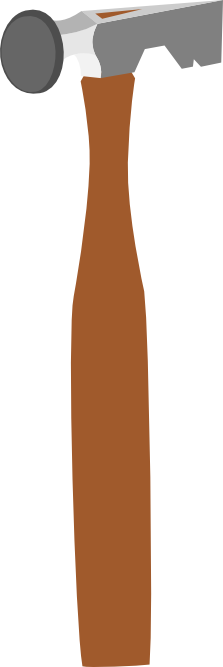
Drywall Hammer
A drywall hammer, sometimes called a drywall hatchet, is one of the most important tools a drywall hanger owns. What makes a drywall hatchet different from any ordinary hammer?
The first unique characteristic of a drywall hammer is its lightweight. Drywall hammers are generally less than a pound. They usually weigh about 12 - 13 ounces. The light weight is appreciated by drywall hangers for the obvious reason that it is easier to carry around, however it serves a more practical purpose as well. The paper surface of drywall will eventually be finished with drywall compound and painted to create the finished product of the wall. The less collateral damage that is caused when the hammer strikes the drywall paper surface the better. Any imperfections left in the drywall paper by the hammer must be corrected with drywall mud. Therefore a lightweight hammer helps prevent major dings and nicks in the drywall paper surface.
Another feature unique to drywall hammers is the rounded striking surface. This rounded design helps prevent unnecessary nicks and dents in the drywall paper surface as well. In contrast, consider a framing hammer. The striking surface of a framing hammer is almost completely squared-off. If you were to use a framing hammer to drive nails into drywall, every time the face of the hammer did not connect perfectly squarely against the surface of the drywall, the corners of the hammer face would leave dents in the drywall paper. On the other end of the spectrum, a ball-pin hammer has a completely round head. A ball-pin hammer would be very difficult to control when driving drywall nails. It would also leave a deep dent in the drywall paper causing the head of the nail to puncture the surface.

A third characteristic unique to drywall hammers is the hatchet-like tail on the back side of the hammer. This design originated as a tool for plaster workers to chop wood lath strips quickly without needing to pick up a tool. Today, plasterers still appreciate this aspect of the drywall hatchet however drywall hangers have found it to be helpful as well. There are times when a drywall hanger needs to install wooden backing when doing a drywall repair. Though the hatchet on a drywall hammer is not sufficient to cut a two-by-four, it can be used to break smaller one-by's. More frequently, a drywall hanger will use the hatchet end of his hammer as an extension of his arm to grab and carry the lower end of a piece of drywall. Many will use the hatchet to mark the location of light boxes to be later cut out with a Roto-Zip.
Though other types of hammers can be used when installing drywall panels, because of the unique characteristics of the drywall hatchet, it is the best-suited hammer for the task. For anyone needing to hang more than a few sheets of drywall, it makes sense to purchase a drywall hammer.
